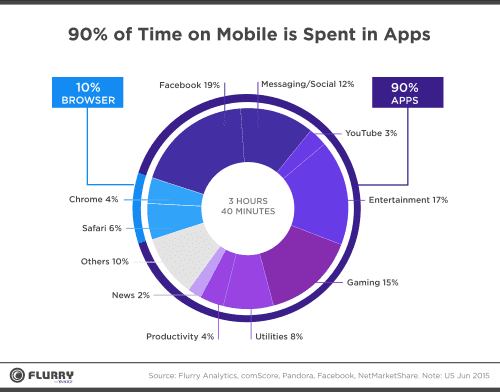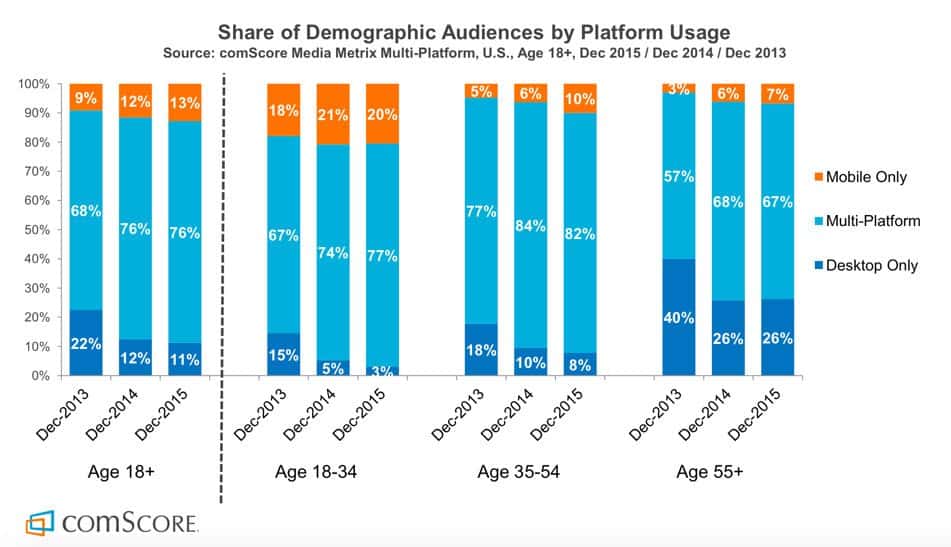Can you segment the Baby Boomer, Gen-Z, or the Millennial in this picture?
 Google can. Google also says their platform is now used for searches about 60% of the time from mobile devices in the US. However, this is not the end of the story.
Google can. Google also says their platform is now used for searches about 60% of the time from mobile devices in the US. However, this is not the end of the story.
One would think from current headlines that the entire world has thrown their old laptop/desktop into the recycle bin, but that is not what user statistics actually reveal.
According to Smart Insights, most of the time spent on mobile devices, 90% to be precise, is spent using an app (think Facebook, etc.). Even though the total number of digital hours people spend on mobile is higher than desktops, this is mainly because people use their apps for everything under the sun. But when it comes to actually “surfing the web,” people are only spending about 10% of their digital hours looking for answers on a handheld device. That’s not very impressive.
So why is Google so bullish on mobile devices?
 Here’s how their abundant enthusiasm is reckoned: For typical website inquiries in 2017, web searches most often begin on a mobile device of some kind. This often satisfies those looking for a quick answer. However, some web searchers needing deeper answers to more complex questions about products, issues, or problems either start or continue their research on a desktop platform.
Here’s how their abundant enthusiasm is reckoned: For typical website inquiries in 2017, web searches most often begin on a mobile device of some kind. This often satisfies those looking for a quick answer. However, some web searchers needing deeper answers to more complex questions about products, issues, or problems either start or continue their research on a desktop platform.
This is a vital piece of information if you are trying to create a website strategy that meets the needs of today’s online clientele regardless of the type of business you operate.
Marketing folks like to call this behavior the customer journey. It is a significant subset of a popular practice that progressive companies embrace known as omnichannel marketing.
We won’t concern ourselves with omnichannel for now, however; this blog considers why your customers’ online behavior should influence your web design, strategy, and approach. Hopefully, a bit of background information will help you think about how your particular customers behave online, making this research more relevant to your business’ online marketing needs.
What are your customers doing for online search?
The real story is not that people are using mobile devices for searches. We get that. What we may not be getting with the same sense of urgency is how the practice of using multiple devices are the biggest part of the customer journey. This is called multi-platform search, and it is the most common method by far for those that are likely to engage with your online presence.
So where are all of the headlines talking about Multi-Platform Search? Sorry folks, it’s not very sexy to talk about mixing what some people like to think of as an old device (e.g. laptop) with the latest, hottest, biggest, flattest (add more adjectives here) smartphone the world has ever seen.
I recently logged on to the website of one of my B2B clients who has a national focus and viewed their analytics. Very telling. In the last three years, the number of mobile devices people used to find them went from less than 3% to about 15% today. Now contrast this with the national average of visits via mobile in the retail sector, which is upwards of 75%. You can see where the trend is heading, just like Google’s research suggests.
OK, this is the part of my blog where you need to do something, that is if you would like to work on and improve your customer journey to purchase. Login to your website’s analytics and get the total ratio of mobile vs. desktop visits for the last three years.
Once you have your ratio of mobile vs. desktop visitors to your website, we must ask: Does the proportion of people finding you online agree with how your site design, functions, and user experience play out? If you cannot honestly answer yes, you are in danger of becoming irrelevant on the web, regardless of how much money you spend on SEO and advertising. Customer convenience leads to satisfaction and is part of the outcome of a great user experience, and it may just be your best competitive advantage.
Please report these numbers to your head of marketing before you risk losing more of your relevance on the web. Then engage a competent web design and marketing company to help you interpret, create, and implement a plan of action if you don’t have these skills in-house.
Today, there are many strategies and tactics to yield results from the Internet. And your website may be only a part of a multi-platform approach that actually puts your presence in the format that people need. Not everyone has the same preferences, and casting everyone in the same mold is a grave mistake.
Regardless of what you find when your review your website’s browser statistics, the correct answer for your company is going to be decidedly your own. That’s because most industries have customers with diverse needs, values, habits, and experiences.
Better marketing uses the best science but still relates to people by being an art. Finding the right balance is critical to success and is often out of kilter today because digital marketers overuse disruption techniques that violate important marketing principles, such as, don’t annoy people!
A solid marketing plan positions your business both offline and online to
- communicate your unique selling point
- deliver awesome goods or services that reflect your value proposition
- focus on the customer
- do or create something good that people believe in
If you are in the majority of companies who need a website to reach your client, then today’s research says it should at least be mobile friendly. This is just the starting point to begin thinking about your customer journey. The more you know about your customers’ journey, the better you will understand what kind of marketing strategy will best serve your company’s goals in the years ahead.
















